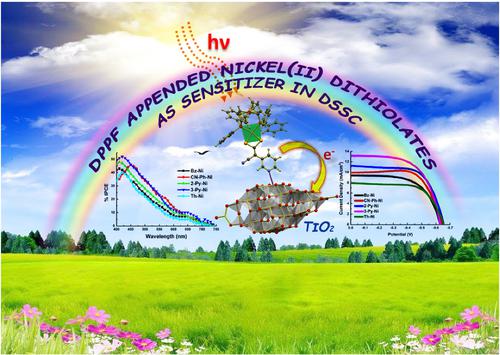当前位置:
X-MOL 学术
›
Appl. Organomet. Chem.
›
论文详情
Our official English website, www.x-mol.net, welcomes your feedback! (Note: you will need to create a separate account there.)
Effect of different aromatic groups on photovoltaic performance of 1,1′-bis (diphenylphosphino)ferrocene functionalized Ni (II) dithiolates as sensitizers in dye sensitized solar cells
Applied Organometallic Chemistry ( IF 3.9 ) Pub Date : 2021-08-18 , DOI: 10.1002/aoc.6402 Amita Singh 1 , Archisman Dutta 2, 3 , Devyani Srivastava 2 , Gabriele Kociok‐Köhn 4 , Ratna Chauhan 5 , Suresh W. Gosavi 6 , Abhinav Kumar 2 , Mohd. Muddassir 7
Applied Organometallic Chemistry ( IF 3.9 ) Pub Date : 2021-08-18 , DOI: 10.1002/aoc.6402 Amita Singh 1 , Archisman Dutta 2, 3 , Devyani Srivastava 2 , Gabriele Kociok‐Köhn 4 , Ratna Chauhan 5 , Suresh W. Gosavi 6 , Abhinav Kumar 2 , Mohd. Muddassir 7
Affiliation

|
A series of five new heteroleptic 1,1′-bis (diphenylphosphino)ferrocene (dppf) appended nickel (II) dithiolates namely, [Ni (dppf)(benzylcyanidedithiolate)] (Bz-Ni), [Ni (dppf)(2-cyanobenzylcyanidedithiolate)] (CN-Ph-Ni) and [Ni (dppf)(pyridine-2-cyanidedithiolate)] (2-Py-Ni), [Ni (dppf)(pyridine-3-cyanidedithiolate)] (3-Py-Ni), Ni (dppf)(thiophene-2-cyanidedithiolate)] (Th-Ni) have been prepared and characterized using spectroscopic techniques and in one case by single-crystal X-ray diffraction analysis for CN-Ph-Ni. The geometry around Ni (II) in CN-Ph-Ni is distorted square planar which is fulfilled by two S and two P centers of dithiolate and dppf ligand, respectively. The electronic absorption spectra for sensitizers display major bands between 400 and 550 nm that could be ascribed to an intra-molecular charge transfer (ICT) between the ferrocene and functionalized dithiolates to engender an efficient charge separated state. All these newly synthesized compounds are used as sensitizers in dye sensitized solar cells (DSSCs). The photovoltaic performances for the five featured sensitizers follow the order 3-Py-Ni>2-Py-Ni˃CN-Ph-Ni˃Bz-Ni˃Th-Ni. The assembly fabricated with 3-Py-Ni displays Jsc of 13.15 mA cm−2 and Voc of −0.633 with conversion efficiency (η) and incident photon-to-current conversion efficiency (IPCE) of 5.05% and 52%, respectively. The relatively slower charge recombination, greater dye loading capacity on TiO2 nano-particulate and relative smaller total resistance are the possible reasons behind the superior photovoltaic performance of the cell fabricated using the 3-Py-Ni as sensitizer. Also, density of states calculations have been performed which suggested that in the best performer 3-Py-Ni+(TiO2)30 cell set-up, the minimum inter-band excitation energy lies ~1.4 eV. Also, efficient electron coupling between sensitizer and (TiO2)30 results in efficient sensitization of TiO2 nanocluster.
中文翻译:

不同芳基对染料敏化太阳能电池中作为敏化剂的 1,1'-双 (二苯基膦) 二茂铁功能化 Ni (II) 二硫醇盐光伏性能的影响
一系列五种新型杂配基 1,1'-双 (二苯基膦) 二茂铁 (dppf) 附加镍 (II) 二硫醇盐,即 [Ni (dppf)(benzylcyanidedithiolate)] ( Bz-Ni )、[Ni (dppf)(2-氰苄基氰二硫醇盐)] ( CN-Ph-Ni ) 和 [Ni (dppf)(pyridine-2-cyanidedithiolate)] ( 2-Py-Ni ), [Ni (dppf)(pyridine-3-cyanidedithiolate)] ( 3-Py- Ni )、Ni (dppf)(噻吩-2-氰化二硫醇盐)] ( Th-Ni ) 已使用光谱技术制备并表征,在一种情况下通过CN-Ph-Ni的单晶 X 射线衍射分析。CN-Ph-Ni 中Ni (II) 周围的几何形状是扭曲的方形平面,分别由二硫醇和 dppf 配体的两个 S 和两个 P 中心实现。敏化剂的电子吸收光谱显示 400 到 550 nm 之间的主要波段,这可能归因于二茂铁和功能化二硫醇之间的分子内电荷转移 (ICT),从而产生有效的电荷分离状态。所有这些新合成的化合物都用作染料敏化太阳能电池 (DSSC) 的敏化剂。五种特色敏化剂的光伏性能遵循3-Py-Ni > 2-Py-Ni ˃ CN-Ph-Ni ˃ Bz-Ni ˃ Th-Ni 的顺序。用3-Py-Ni制造的组件显示J sc13.15 mA cm -2和 V oc为 -0.633,转换效率 ( η)和入射光子到电流转换效率 (IPCE) 分别为 5.05% 和 52%。相对较慢的电荷复合、较大的 TiO 2纳米颗粒上的染料负载能力和相对较小的总电阻是使用3-Py-Ni作为敏化剂制造的电池具有优异光伏性能的可能原因。此外,已经进行了态密度计算,这表明在性能最好的3-Py-Ni +(TiO 2 ) 30单元设置,最小带间激发能量为~1.4 eV。此外,敏化剂和(TiO 2 ) 30之间的有效电子耦合导致TiO 2纳米团簇的有效敏化。
更新日期:2021-10-20
中文翻译:

不同芳基对染料敏化太阳能电池中作为敏化剂的 1,1'-双 (二苯基膦) 二茂铁功能化 Ni (II) 二硫醇盐光伏性能的影响
一系列五种新型杂配基 1,1'-双 (二苯基膦) 二茂铁 (dppf) 附加镍 (II) 二硫醇盐,即 [Ni (dppf)(benzylcyanidedithiolate)] ( Bz-Ni )、[Ni (dppf)(2-氰苄基氰二硫醇盐)] ( CN-Ph-Ni ) 和 [Ni (dppf)(pyridine-2-cyanidedithiolate)] ( 2-Py-Ni ), [Ni (dppf)(pyridine-3-cyanidedithiolate)] ( 3-Py- Ni )、Ni (dppf)(噻吩-2-氰化二硫醇盐)] ( Th-Ni ) 已使用光谱技术制备并表征,在一种情况下通过CN-Ph-Ni的单晶 X 射线衍射分析。CN-Ph-Ni 中Ni (II) 周围的几何形状是扭曲的方形平面,分别由二硫醇和 dppf 配体的两个 S 和两个 P 中心实现。敏化剂的电子吸收光谱显示 400 到 550 nm 之间的主要波段,这可能归因于二茂铁和功能化二硫醇之间的分子内电荷转移 (ICT),从而产生有效的电荷分离状态。所有这些新合成的化合物都用作染料敏化太阳能电池 (DSSC) 的敏化剂。五种特色敏化剂的光伏性能遵循3-Py-Ni > 2-Py-Ni ˃ CN-Ph-Ni ˃ Bz-Ni ˃ Th-Ni 的顺序。用3-Py-Ni制造的组件显示J sc13.15 mA cm -2和 V oc为 -0.633,转换效率 ( η)和入射光子到电流转换效率 (IPCE) 分别为 5.05% 和 52%。相对较慢的电荷复合、较大的 TiO 2纳米颗粒上的染料负载能力和相对较小的总电阻是使用3-Py-Ni作为敏化剂制造的电池具有优异光伏性能的可能原因。此外,已经进行了态密度计算,这表明在性能最好的3-Py-Ni +(TiO 2 ) 30单元设置,最小带间激发能量为~1.4 eV。此外,敏化剂和(TiO 2 ) 30之间的有效电子耦合导致TiO 2纳米团簇的有效敏化。



























 京公网安备 11010802027423号
京公网安备 11010802027423号